Has a meal ever made such an impact that it’s become forever seared into your memory? The colors, the presentation, the way the bread felt on your fingertips. It made such an impression that you still think about it twenty, even thirty years later.
That’s what happened with me and Ethiopian food in the early 90s. I had it for the first time at the Red Sea restaurant in Washington, DC and I’ve been thinking about it ever since.
It wasn’t just the taste of the food that made an impression on me. It was the whole experience. From the way the colorful stews were served together on a large pancake to the way you ate them with your hands using small pieces of injera, I was mesmerized from start to finish.
Injera was especially fascinating for me because I had never touched nor tasted bread with that kind of texture. At the time, it was truly a unique experience, one that obviously had a lasting impact on me.
I enjoyed that Ethiopian meal so much that I wound up having it again a few days later, at a different restaurant. Unfortunately, Ethiopian restaurants have been few and far between since then which is why I’m planning a trip to Addis Ababa to enjoy Ethiopian food where it’s really from.
If you’re curious about Ethiopian food and planning a trip to Africa, then be sure to check out these 20 traditional dishes when you visit Ethiopia.
Save This on Pinterest!
No time to read this guide on traditional Ethiopian food? Click on the save button and pin it for later!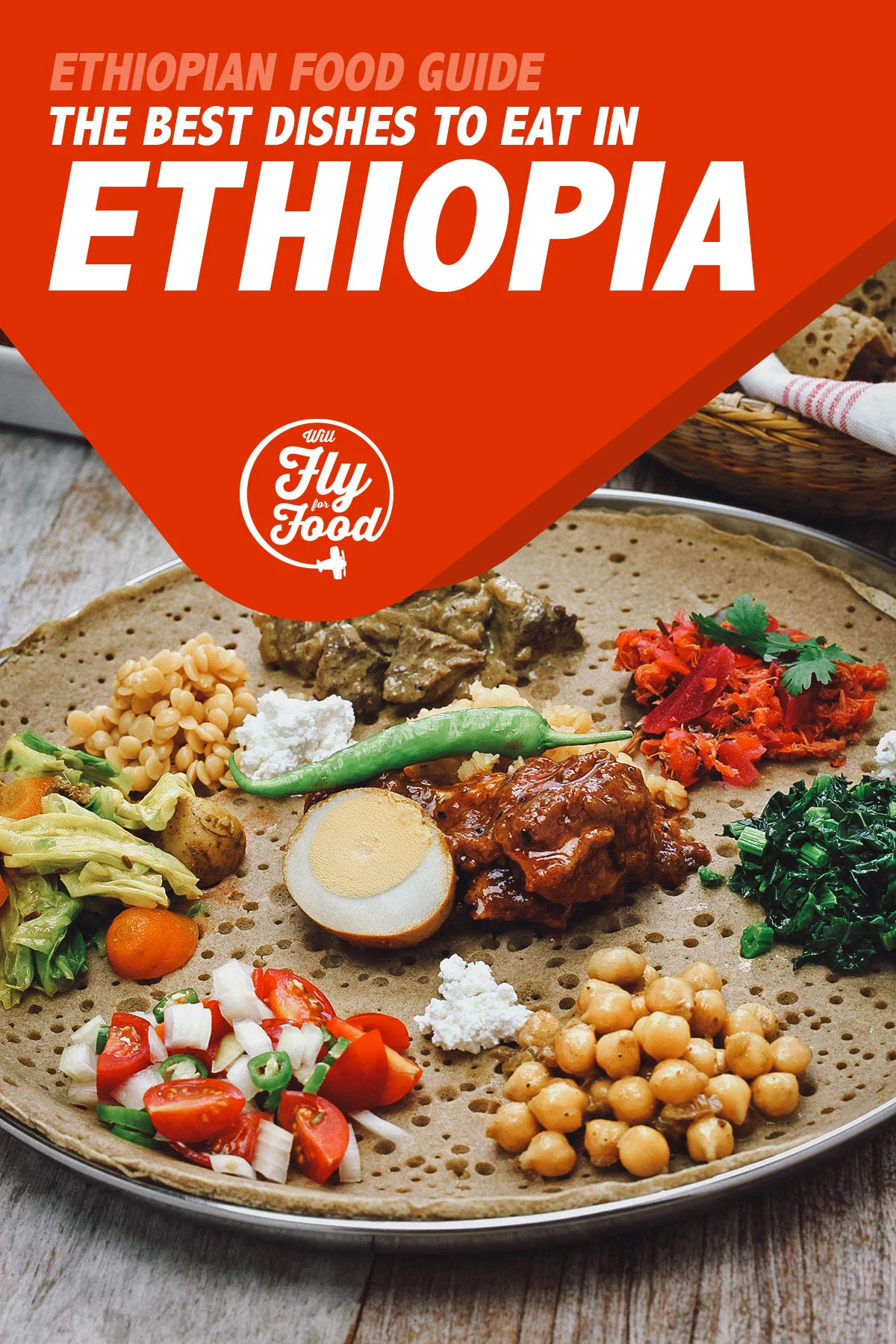
Photo by asimojet
WHAT IS TRADITIONAL ETHIOPIAN FOOD?
Traditional Ethiopian food has to be one of the most unique dining experiences in the world. Laden with spices and eaten entirely by hand, it’s a cuisine that’s as distinctive as it is delicious.
The typical Ethiopian meal consists of numerous vegetable dishes and spicy meat stews and curries served over a giant pancake-like flat bread called injera. To eat, diners break pieces of injera with their hands and use it as a scoop to pick up the food. Like Moroccans, Ethiopians eat using only their right hands as the left hand is considered unclean.
Traditional Ethiopian cuisine bears a resemblance to Indian food, especially in its heavy use of spices. One of the most commonly used ingredients in Ethiopian cooking is berbere, a potent Ethiopian spice mix consisting of up to sixteen different spices like chili powder, cardamom, fenugreek, cloves, nutmeg, coriander, and cumin. It’s used to flavor many dishes when cooking Ethiopian food.
Aside from its spicy meat stews and curries, Ethiopia is home to many vegetarian and vegan options. This is because Ethiopia is predominantly a Christian country with about 43.5% of the population belonging to the Ethiopian Orthodox Tewahedo Church.
The church prescribes a number of fasting days which are observed religiously in Ethiopia. As a result, almost everyone eats a vegetarian diet on Wednesdays and Fridays and throughout the entire Lenten season. With tasty vegetarian offerings like bayenetu to look forward to, meat eaters surely won’t miss a thing.
HOW TO EAT TRADITIONAL ETHIOPIAN FOOD
Unlike western food cultures, Ethiopians do away with cutlery so it may take some getting used to for people unaccustomed to eating with their hands.
The typical Ethiopian meal consists of several meat and vegetable stews and curries served on top of a large round piece of injera bread measuring about 50 cm (20 in) in diameter. Served on a metal tray, it’s a highly communal affair with diners gathering around the tray to eat with their hands.
Using their right hand, diners break pieces off the injera and use it as a scoop to pick up cubes of meat and clumps of thick stew. It may take some getting used to for some people but the porous texture of the injera makes it an ideal vessel for scooping up the saucy curries and rich stews.
If desired, diners can partake in a traditional Ethiopian gesture called gursha. Meaning “mouthful” in Amharic, it entails wrapping a bite of food in injera and feeding it to someone else at the table. The person given the bite then returns the favor.
Gursha is an intimate gesture that’s considered a sign of respect in Ethiopian culture. The person receiving the bite of food is called the gorash while the person giving it is the agurash. The larger the gursha, the stronger the friendship or bond.
MUST-TRY TRADITIONAL ETHIOPIAN DISHES
This Ethiopian food guide has been organized by category to make it easier to digest. Click on a link to jump to any section of the guide.
ETHIOPIAN BREAD / PASTRIES
1. Injera
There’s no better way to start this Ethiopian food guide than with injera, the cornerstone of Ethiopian cuisine. This sour fermented flatbread is more than just food, it’s a vessel for eating and the perfect foil to the spicy foods of Ethiopian cuisine.
Injera is an Ethiopian flatbread made from tef, the smallest grain in the world. Ethiopians have been using tef for thousands of years but in the west, it’s been gaining a reputation in recent years as a super food on par with quinoa and spelt. Tef is known for being high in calcium and protein as well as being gluten-free.
Injera is made by mixing teff flour with water and then adding ersho (starter) to begin the fermentation process. The batter is left to ferment for about 2-3 days, to give it a mild sour taste, before baking it into round flat pieces of injera on a large circular griddle called a mitad.
Porous, soft, and spongey, injera has an interesting texture that’s probably unlike any flatbread you’ve ever touched or tasted. It’s highly absorbent and does a great job of soaking up the juices from the curries and stews.
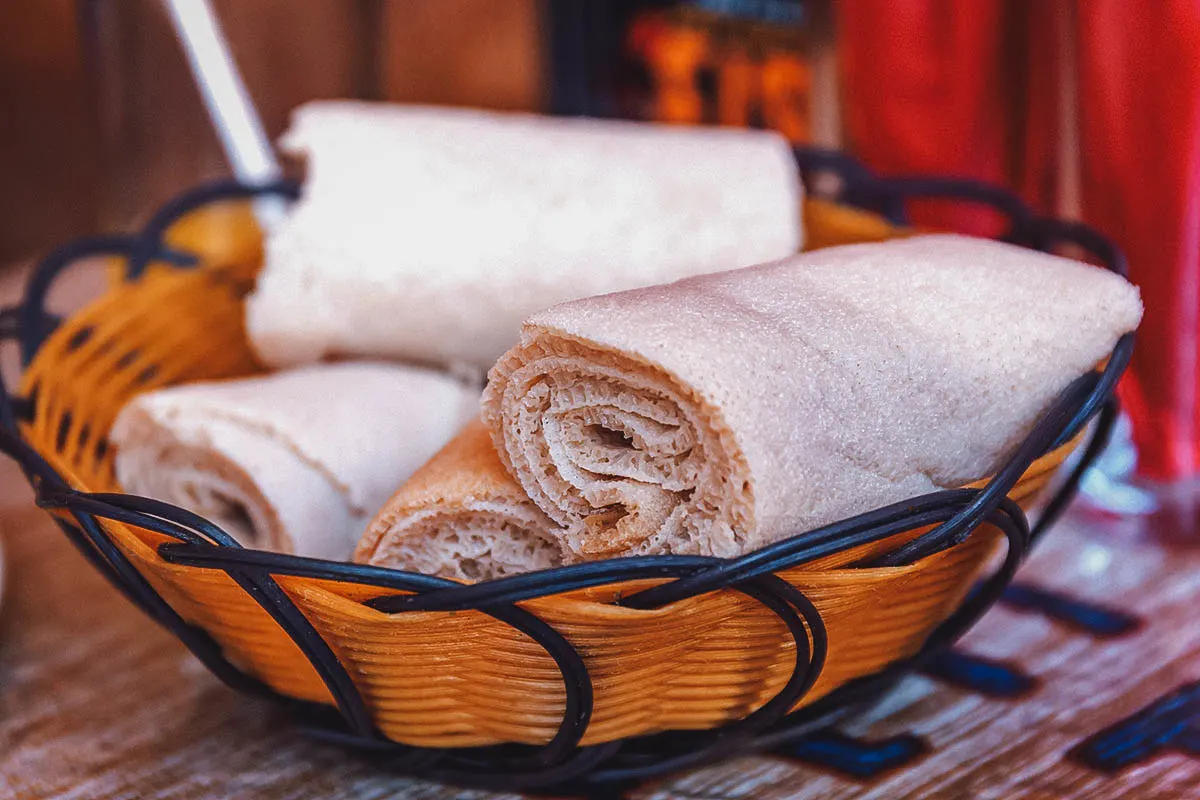
Photo by MagicBones
Injera isn’t just a food and eating utensil, it’s also a plate.
Typical mixed platters will be served with several Ethiopian dishes on a large “tablecloth” of injera along with several rolls. Once you get through the rolls, you’re welcome to tear pieces off the base. The meal is done when the tablecloth of injera is gone.
Aside from Ethiopia, injera is an important part of Eritrean cuisine and is consumed in varying forms in other East African countries like Djibouti, Somalia, and Sudan.
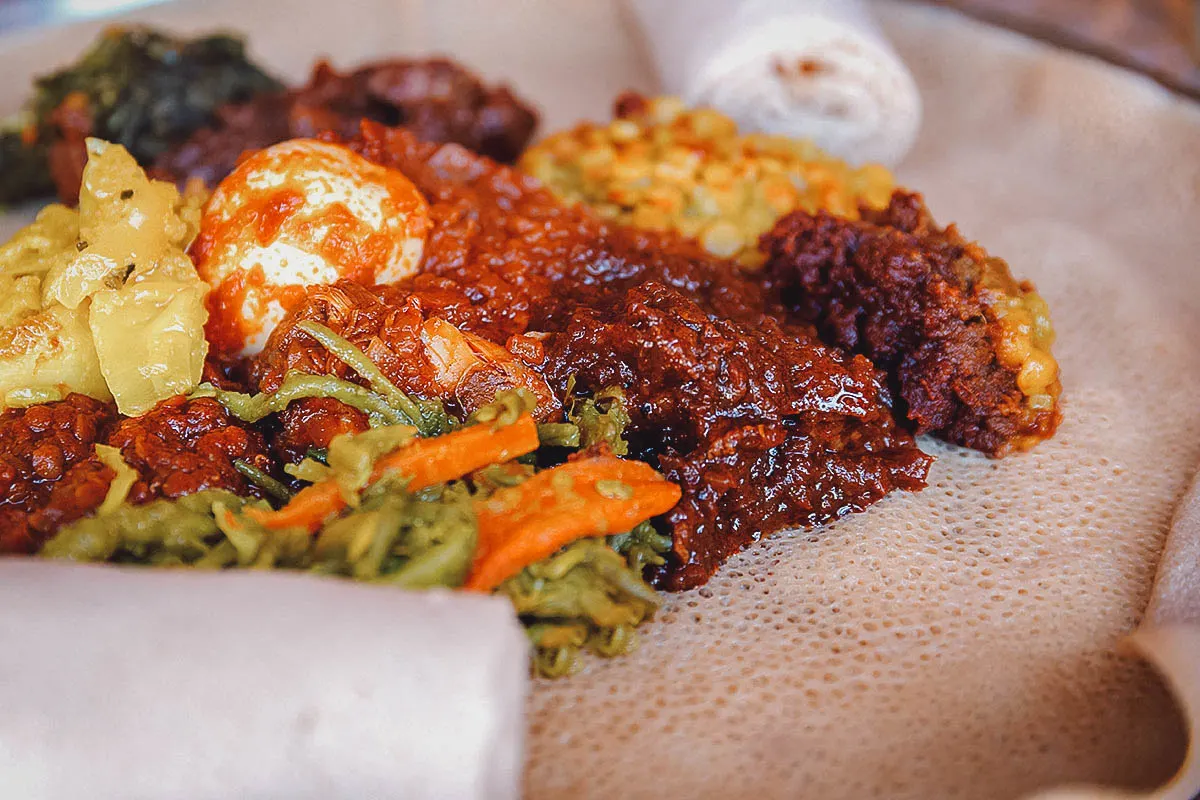
Photo by MagicBones
2. Kitcha
Kitcha (or kita) refers to a type of thin unleavened bread popular in Ethiopian and Eritrean cuisines. It’s made with wheat flour, water, and salt that’s mixed into a dough and then cooked on both sides in a pan with clarified butter.
Kitcha can be eaten on its own but it’s often incorporated into a popular Ethiopian breakfast dish called kitcha firfir (or kitcha fit-fit, chechebsa). It’s made by tearing kitcha flatbread into small pieces and then mixing it with berbere and niter kibbeh, a type of spiced clarified butter made with various spices like besobela (Ethiopian sacred basil), cumin, coriander, korarima (Ethiopian coriander), and koseret.
Kitcha firfir is typically served with a dollop of plain yogurt and paired with hot Ethiopian coffee or tea. Unlike the majority of Ethiopian dishes, it’s eaten with a spoon and not by hand.
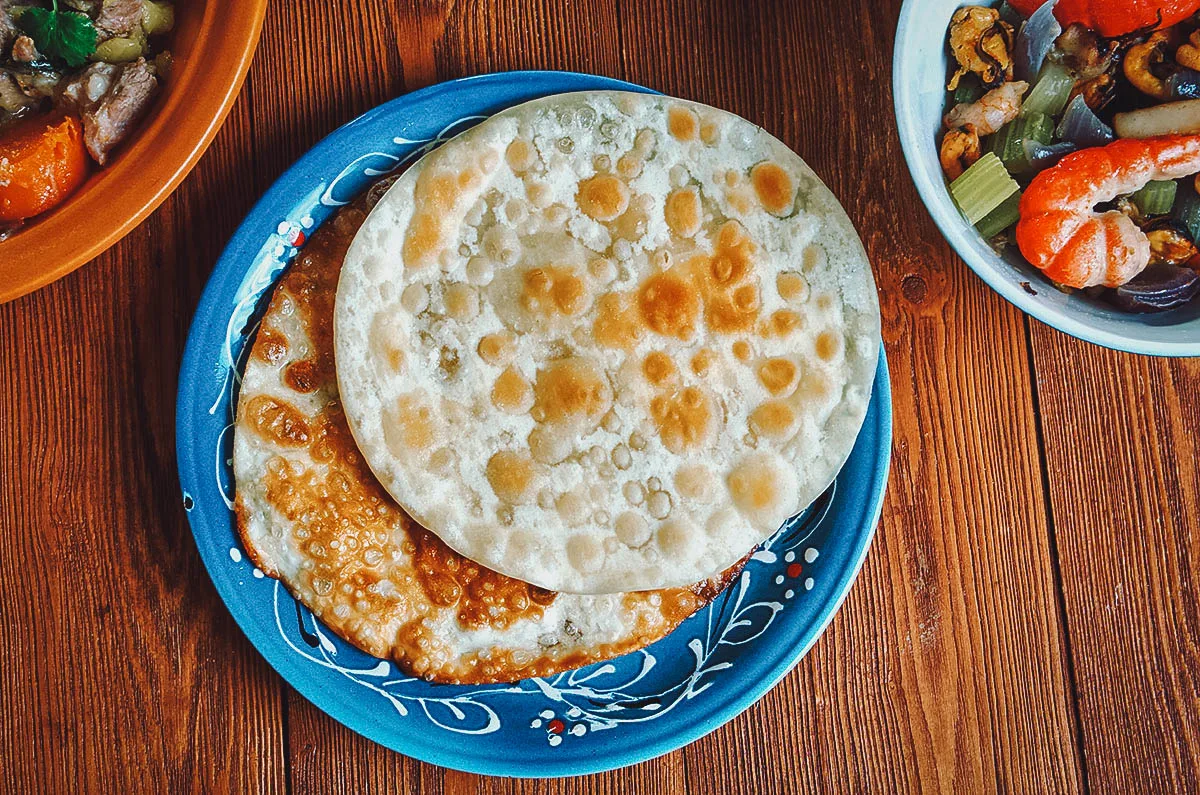
Photo by fanfon
3. Sambusa
As you can probably tell from its name, sambusa is the Ethiopian version of the South Asian samosa. A common street food in Ethiopia and Somalia, it refers to baked or deep-fried pockets of dough filled with either lentils or seasoned ground beef.
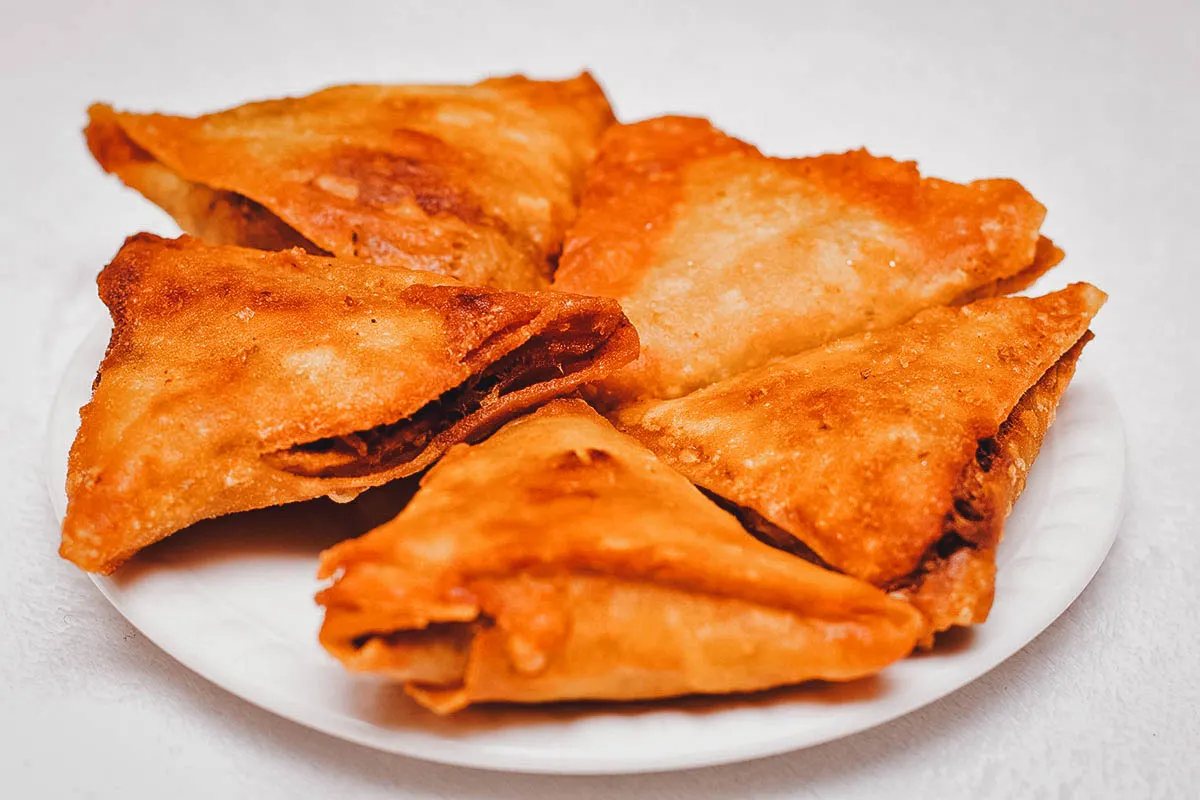
Photo by derejeb
ETHIOPIAN MEAT DISHES
4. Kitfo
If you like steak tartare, then you’ll probably want to try kitfo. It’s an Ethiopian beef tartare made with raw minced beef flavored with niter kibbeh and mitmita, an Ethiopian spice blend made with ground African bird’s eye chili, korarima, cloves, and salt.
Kitfo can be served completely raw or slightly cooked (kitfo leb leb), often with a mild cheese called ayibe or cooked greens known as gomen. Depending on where you are in Ethiopia, it can be served with injera or a thicker type of flatbread called kocho.
Traveleaters interested in the full experience will probably want to try the raw version of kitfo. Because it’s made with raw beef, it’s best to go to a restaurant that specializes in kitfo. Yohaness Kitfo in Addis Ababa is said to be a good place to try this dish.
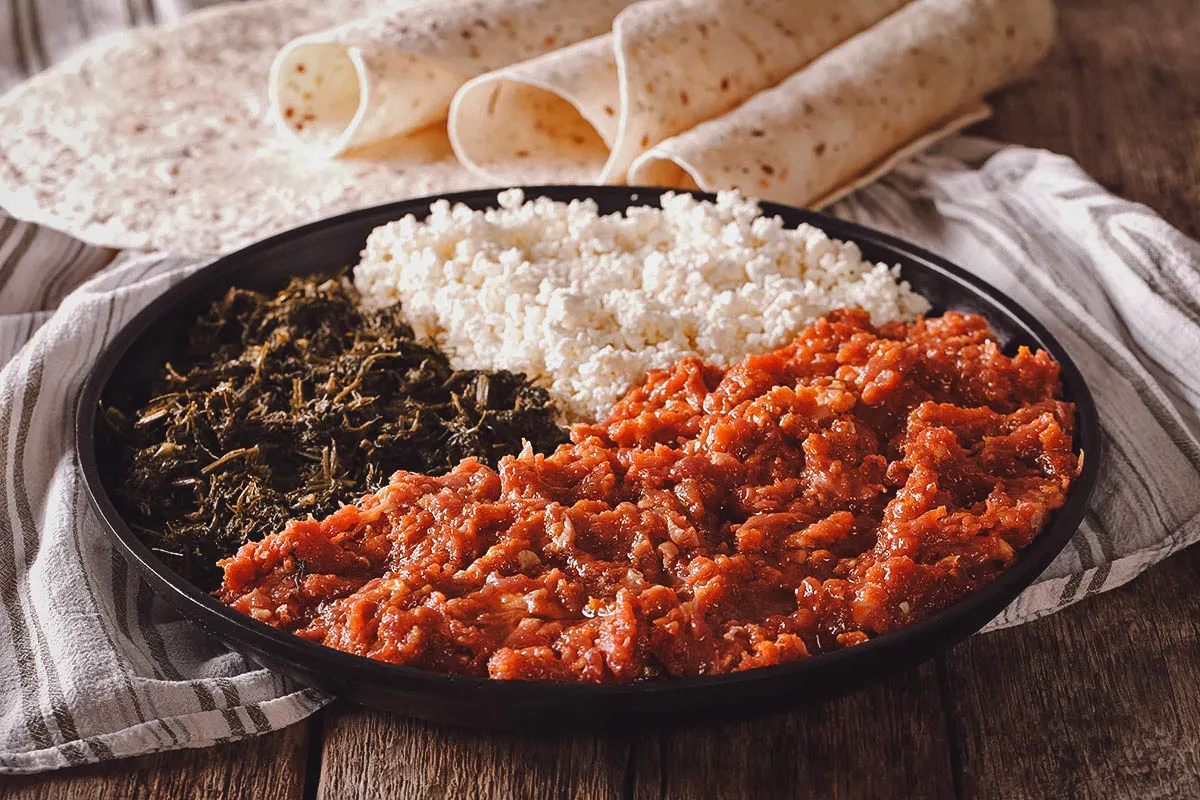
Photo by lenyvavsha
5. Gored Gored
If kitfo piqued your interest, then you may want to try gored gored as well. It’s a similar dish to kitfo except it’s made with cubes of raw beef – usually tenderloin or round steak – seasoned with niter kibbeh, mitmita, berbere, and awaze (chili mustard sauce). Like kitfo, it’s usually served with injera.
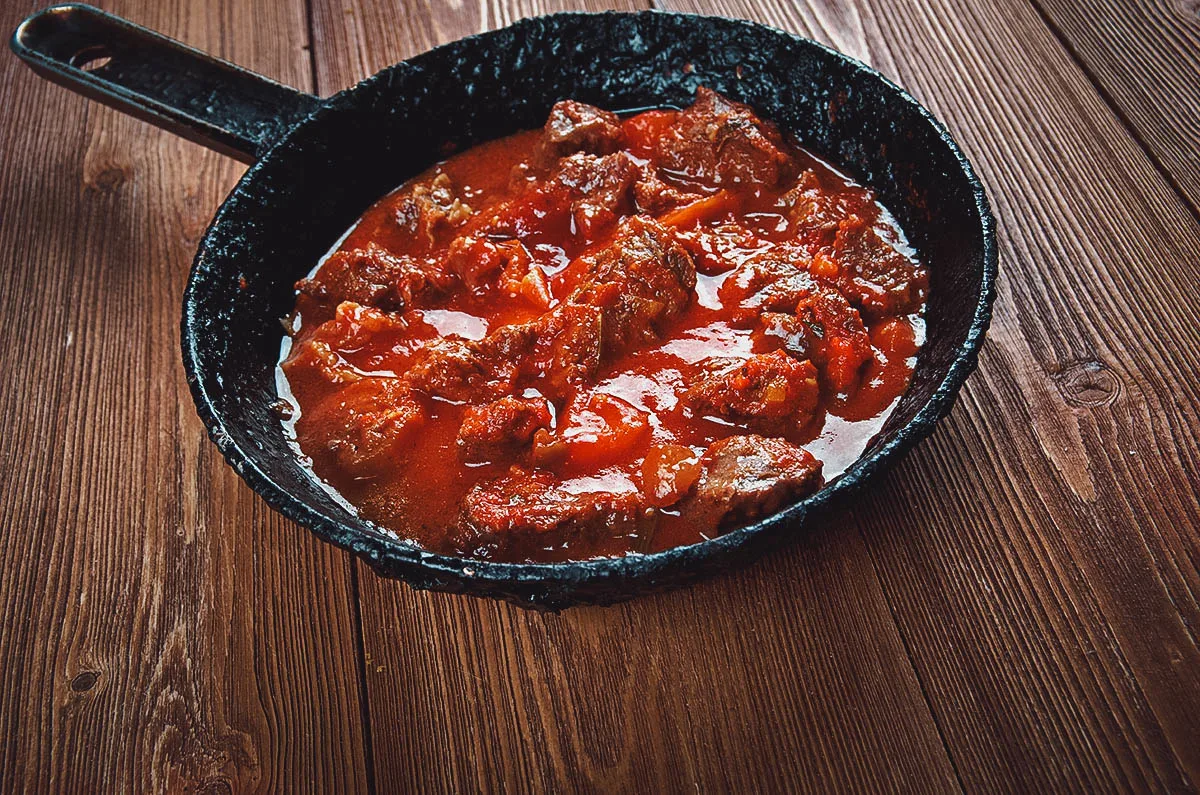
Photo by fanfon
6. Tere Siga
If kitfo and gored gored aren’t extreme enough for you, then perhaps you’d like to try tere siga, an Ethiopian dish of raw meat. The name tere siga literally means “raw meat” and refers to cubes or thick strips of raw red meat cut from the hanging carcass of a freshly slaughtered animal, most often beef.
Unlike kitfo and gored gored which require some preparation, tere siga is unseasoned and eaten only with injera and a side of mitmita and senafich (spicy mustard sauce).
Though most Ethiopians seem to suffer no ill effects from eating tere siga, it’s one of a few Ethiopian dishes on this list that should be approached with caution as eating uncooked meat does pose certain health risks.
It’s believed that eating uncooked meat became a practice in Ethiopia sometime during the 16th century. It was devised as a military tactic so Ethiopian fighters could stay undetected by not having to start fires to cook their meat.
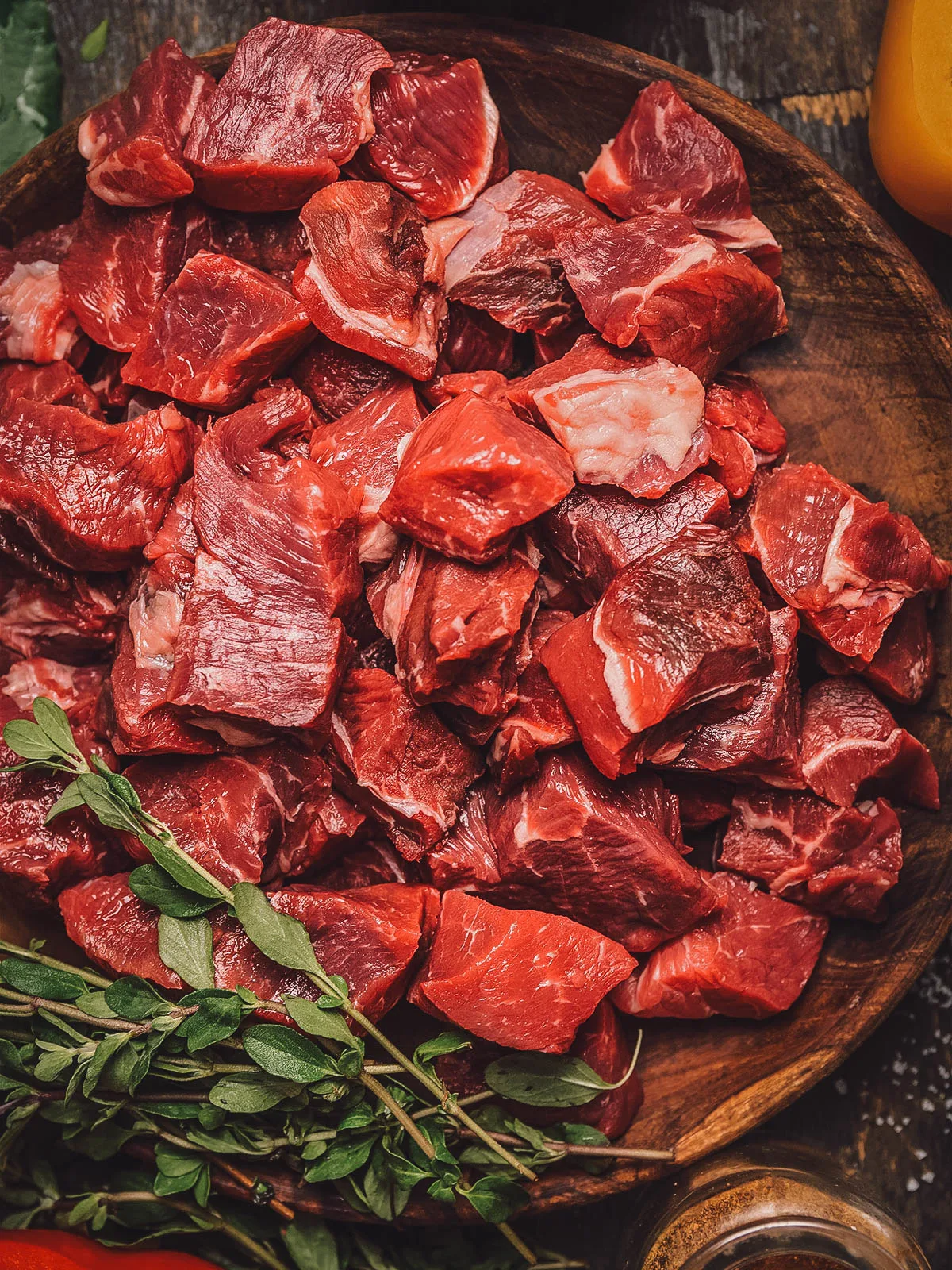
Photo by Vfotografie
7. Doro Wat
Wat (or wot) is one of the most common terms you’ll come across in Ethiopian cuisine. It refers to a type of stew made with a variety of meats, vegetables, and spices.
Doro wat or chicken stew is one of the most popular dishes in Ethiopia and is often served as part of an Ethiopian restaurant’s combination platter. Considered by many to be an Ethiopian national dish, it refers to an extremely spicy stew made with chicken and hard-boiled eggs simmered with garlic, ginger, caramelized onions, tomato paste, and a spicy berbere sauce.
Like most of the dishes in this Ethiopian food guide, it’s best paired with shreds of injera flatbread.
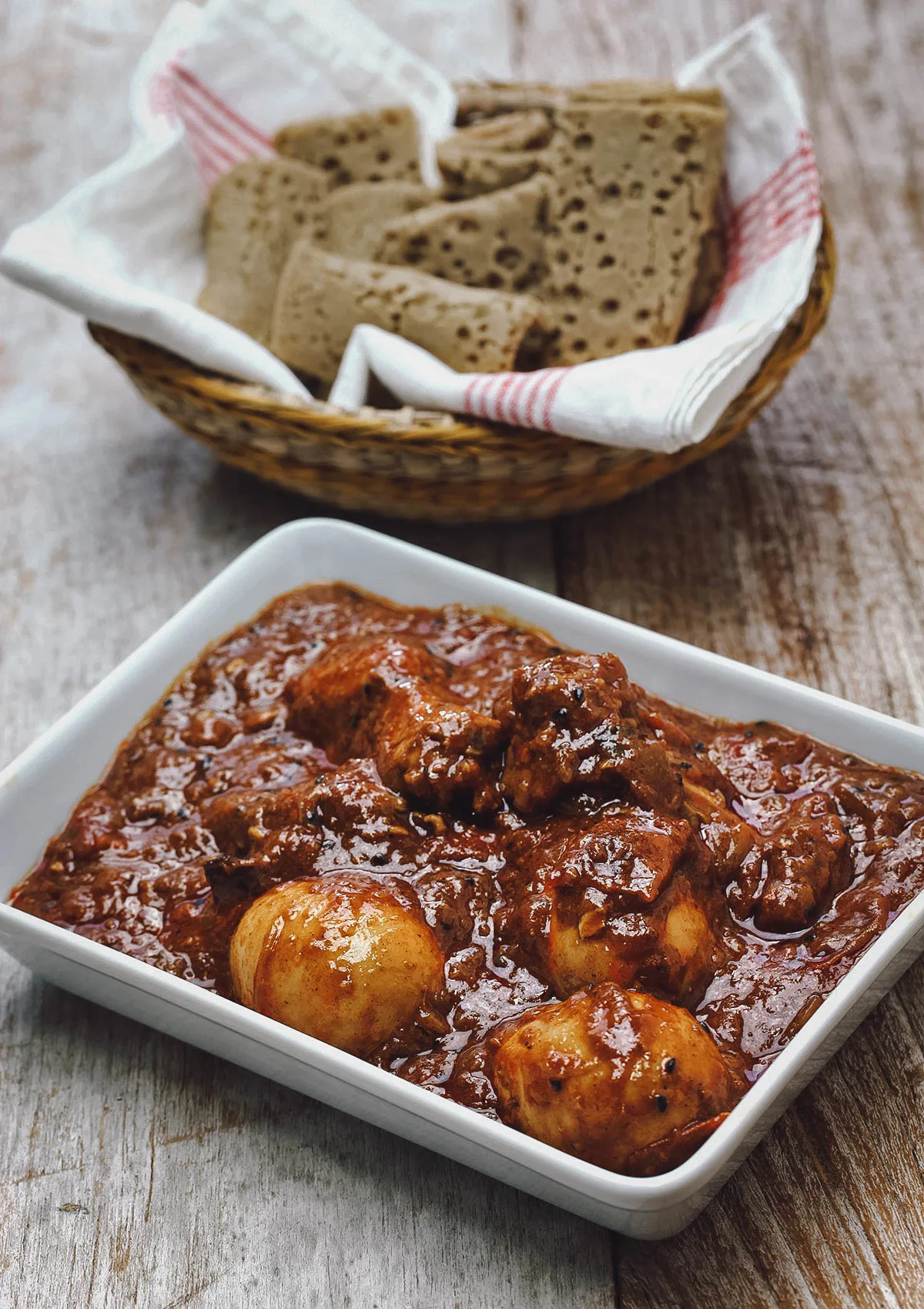
Photo by asimojet
8. Siga Wat
Siga wat (or sega wat) is very similar to doro wat except it’s made with beef instead of chicken. It’s a devilishly spicy stew made with mostly the same ingredients, the most important being the berbere spice blend.
Siga wat is known to be spicy but it can be made into a milder version as well, without the berbere seasoning. The spicy version of siga wat is called keye siga wat while the non-spicy version, made without berbere, is referred to as alecha siga wat.
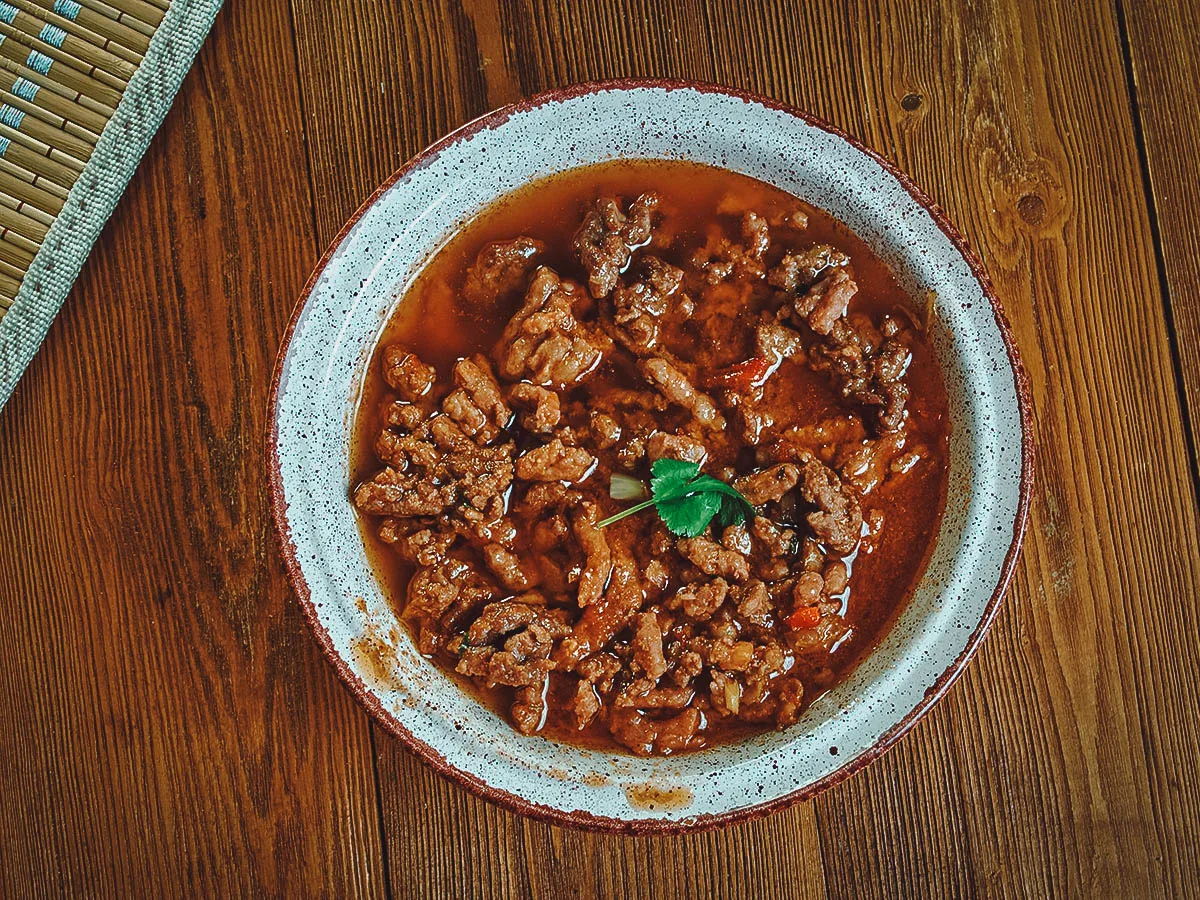
Photo by fanfon
9. Derek Tibs
Tibs refers to a family of Ethiopian dishes made with sautéed meat, vegetables, and berbere. There are many variations of tibs depending on the recipe and cut of meat used, but most are made with beef, lamb, mutton, or venison. They can be spicy or mild, and made with lots of vegetables or none at all.
Derek tibs (or shekla tibs) is a type of tibs made with lamb, beef, or goat cooked with niter kibbeh, onions, peppers, and spices. It’s a drier version of tibs made with meat that’s been pan-fried and seared till slightly crispy. Like many of the dishes in this Ethiopian food guide, it’s usually served with injera and a side of awaze.
Traditionally, tibs was prepared as a show of respect for someone. It continues to be regarded as a special dish though derek tibs has become a popular restaurant food as well. In Addis Ababa, derek tibs is typically served in clay pots with coals at the bottom to keep the meat warm.
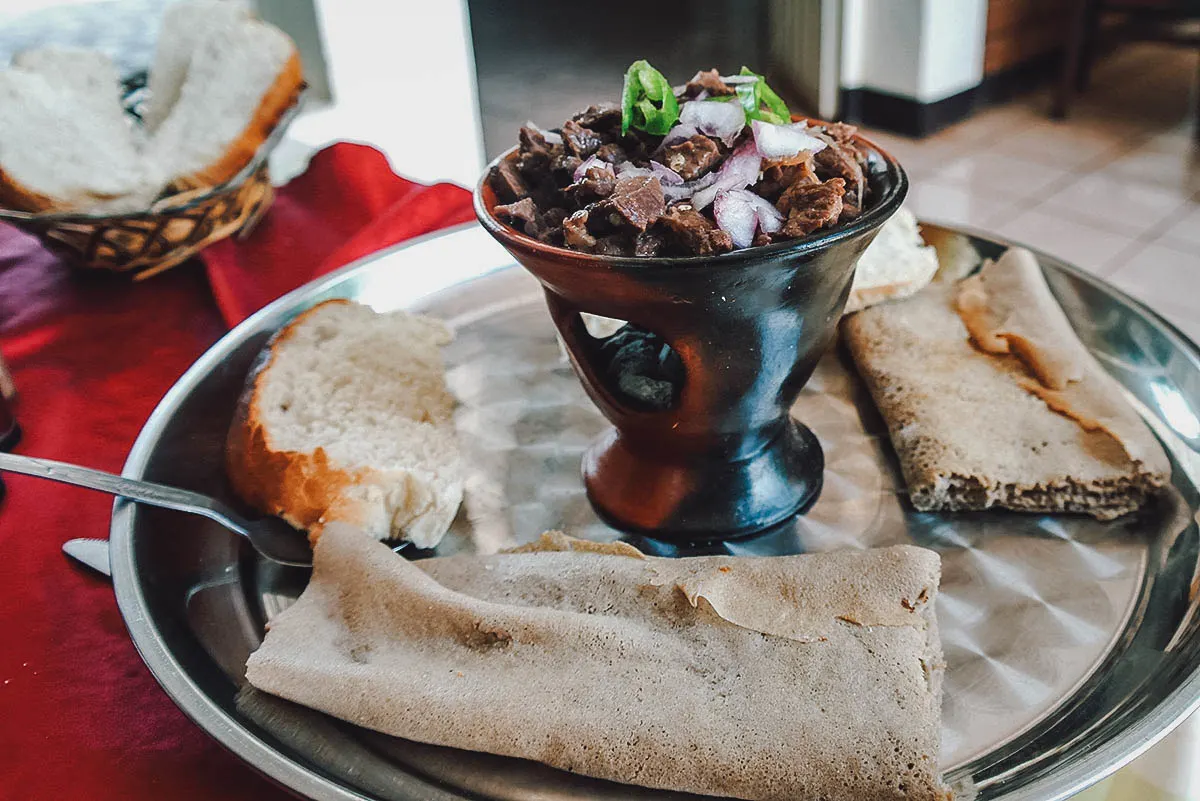
Photo by YAYImages
ETHIOPIAN VEGETARIAN DISHES
10. Kik Alicha
If you don’t have a high tolerance for spicy food, then you’re going to be thankful for kik alicha. It refers to an Ethiopian lentil stew made from split peas, niter kibbeh, and turmeric. Unlike many of the dishes in this Ethiopian food guide, it isn’t made with any berbere so it isn’t nearly as spicy as dishes like doro wat and siga wat.
Kik alicha is a mildly flavored stew made with yellow split peas simmered with garlic, onions, ginger, turmeric, and niter kibbeh. It’s a popular type of vegetarian stew that’s often served as part of a combination platter. Like any wat, it’s best enjoyed with injera.
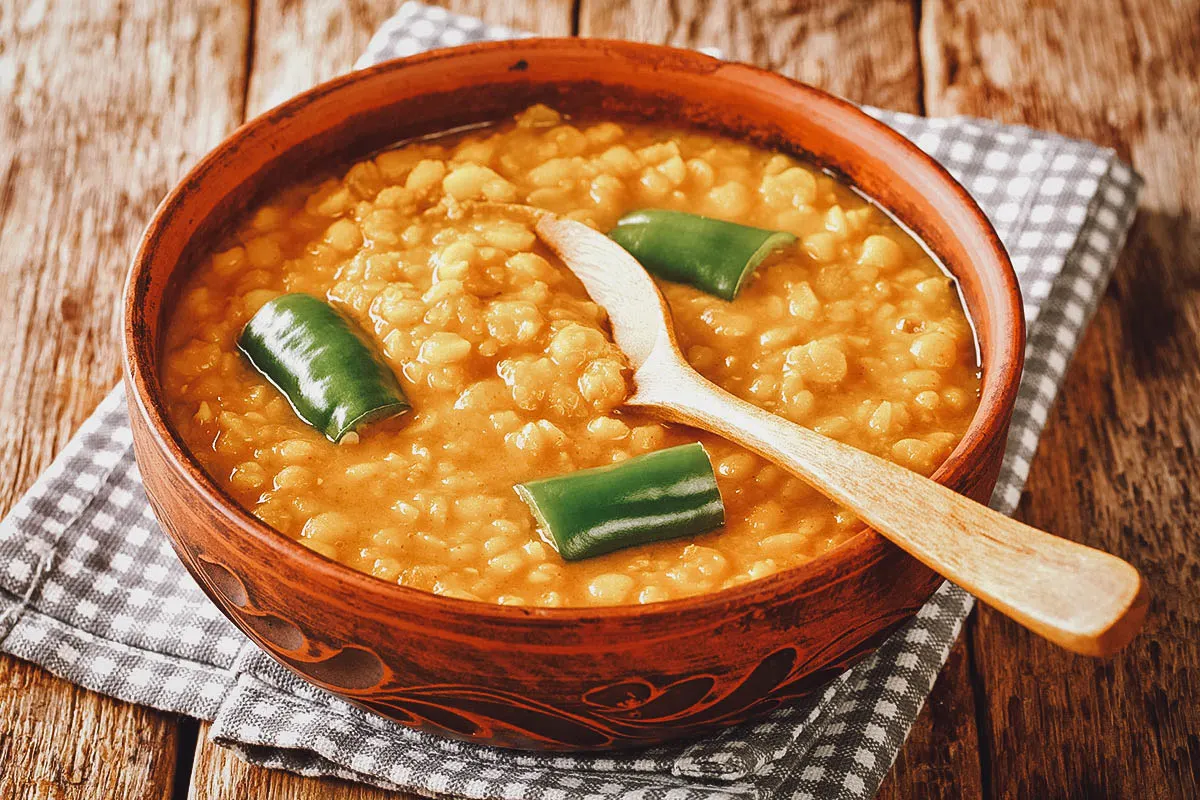
Photo by lenyvavsha
11. Misir Wat
If kik alicha is a little too tame for you, then look no further than misir wat. As you can probably tell from its fiery appearance, it’s a spicy stew made from red lentils, niter kibbeh, and berbere. Like kik alicha, it’s a common dish at restaurants and often served as part of a larger communal platter.
To prepare, onions are slowly simmered with niter kibbeh followed by garlic, tomato paste, and a generous amount of berbere. Red lentils are then added and slowly simmered until they become nice and soft and soak up all the seasonings. Depending on the cook, an extra helping of niter kibbeh and berebere can be thrown in at the end for an even spicier finish.
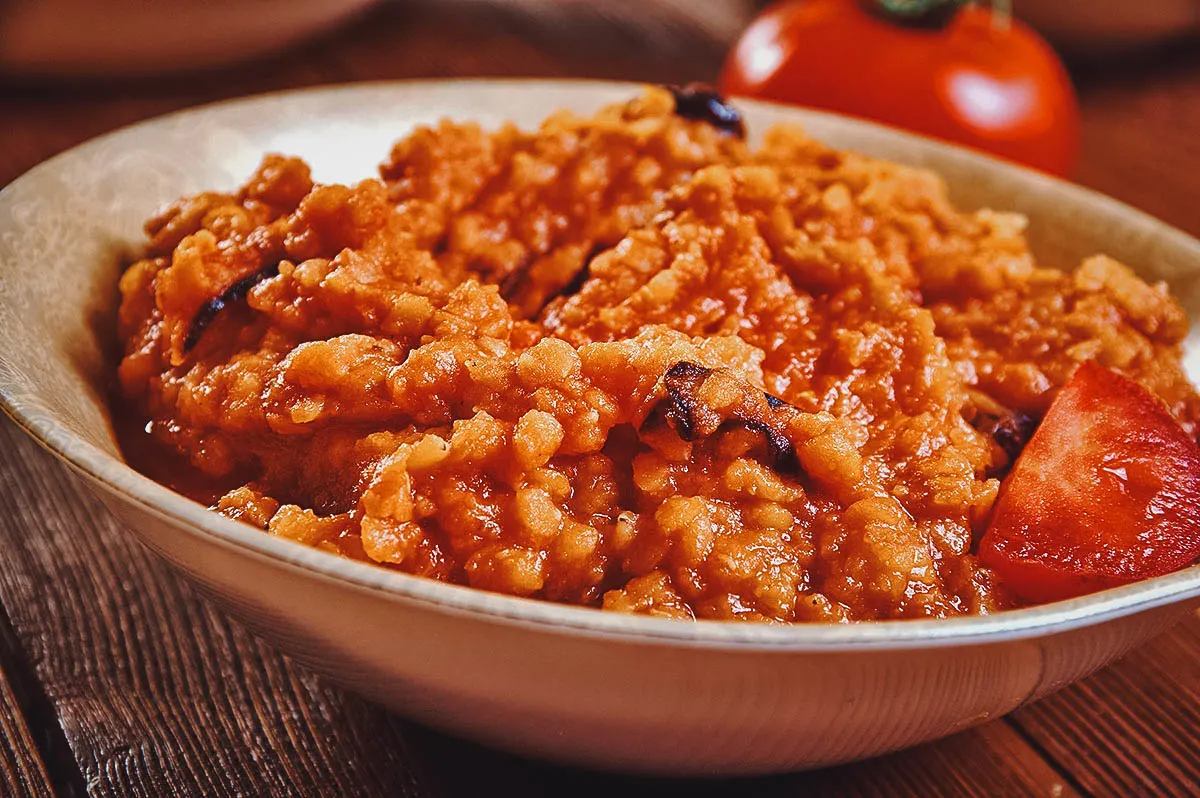
Photo by fanfon
12. Shiro Wat
Like doro wat, shiro wat is one of the most popular types of Ethiopian stews and something you’d surely find on a mixed platter at any Ethiopian restaurant. It’s made with ground chickpea flour cooked with onions, garlic, and other ingredients like ginger, tomatoes, and chili peppers.
Shiro wat has a smooth and creamy texture similar to hummus and is best paired with shreds of injera.
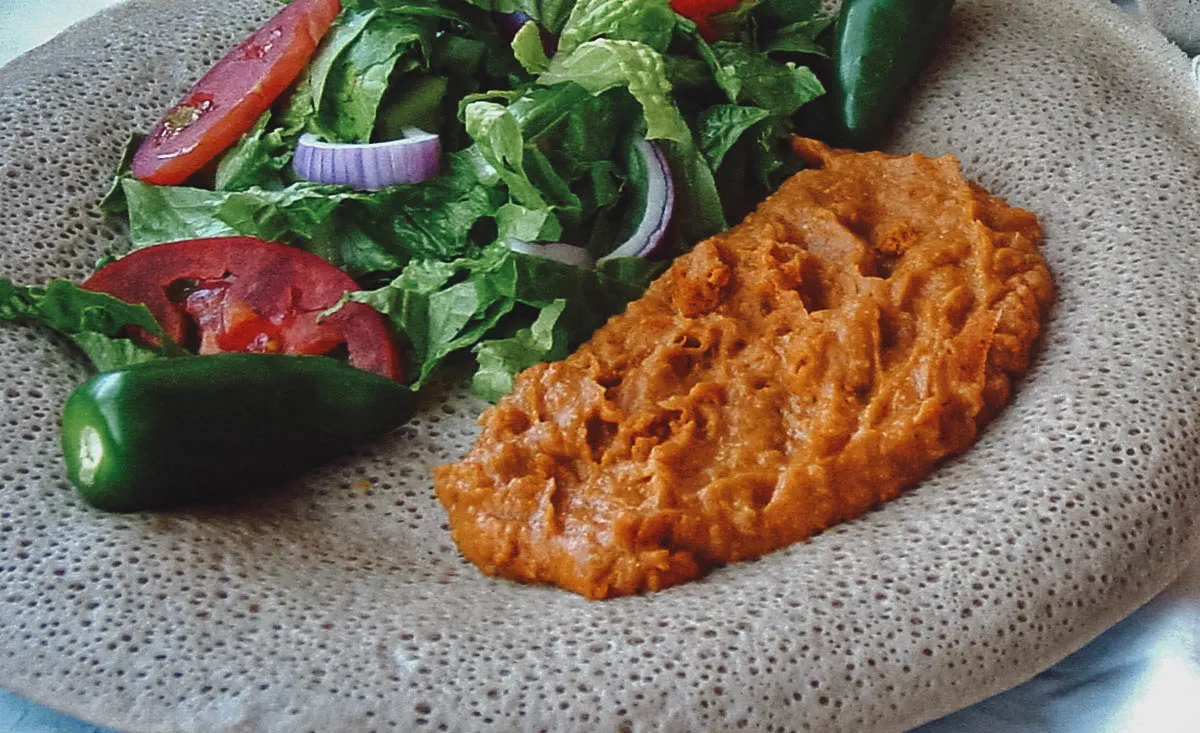
Photo by Temesgen Woldezion; edited by Merhawie Woldezion, CC BY-SA 2.5, via Wikimedia Commons / Processed in Photoshop and Lightroom
13. Genfo
Genfo refers to a thick Ethiopian porridge made with barley or wheat flour. It’s commonly eaten for breakfast with a sauce made from niter kibbeh and berbere.
Genfo is traditionally made with toasted barley flour but in the Ethiopian diaspora, it’s more commonly made with wheat flour or even corn meal. The flour is added to boiling water and stirred constantly with a wooden spoon until it becomes smooth and very thick. It’s a laborious and time-intensive process that takes some physical strength to do, especially when making larger batches of genfo.
When ready, the stiff and slightly sticky porridge is molded into a mound with an indentation in the middle. This is for holding the dipping sauce made with niter kibbeh and berbere. The dish can be eaten as is or served with a side of yogurt.
Like most Ethiopian dishes, genfo is a communal dish that can be eaten by hand, though it’s not uncommon to eat it with a fork or spoon. Chunks or porridge are pulled from the outside and dipped into the butter and spice blend in the middle.
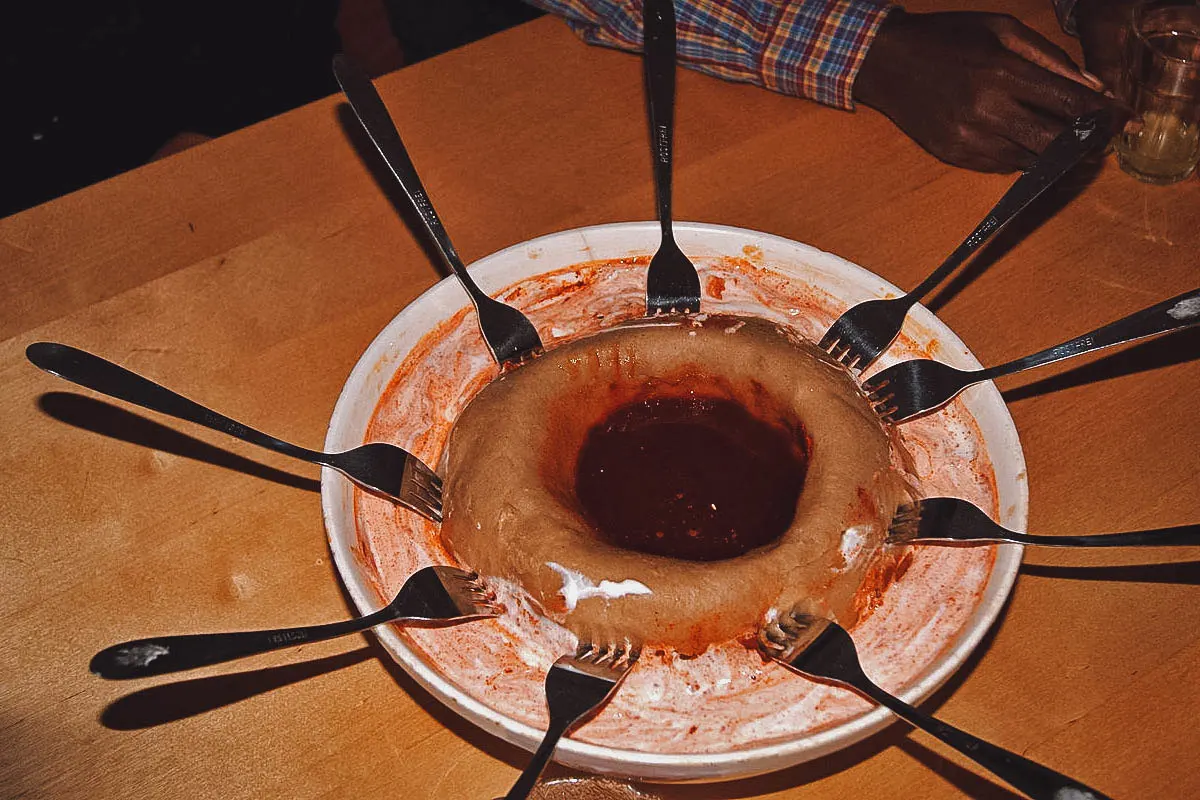
Photo by Stefan Alfons Tzeggai, CC BY-SA 3.0, via Wikimedia Commons / Processed in Photoshop and Lightroom
14. Enkulal Firfir
If you’re in the mood for something a bit more familiar, then perhaps you’d be interested in a breakfast of enkulal firfir, the Ethiopian version of scrambled eggs. It’s made with eggs scrambled in niter kibbeh and mixed with other ingredients like onions, green and red peppers, tomatoes, and chili pepper.
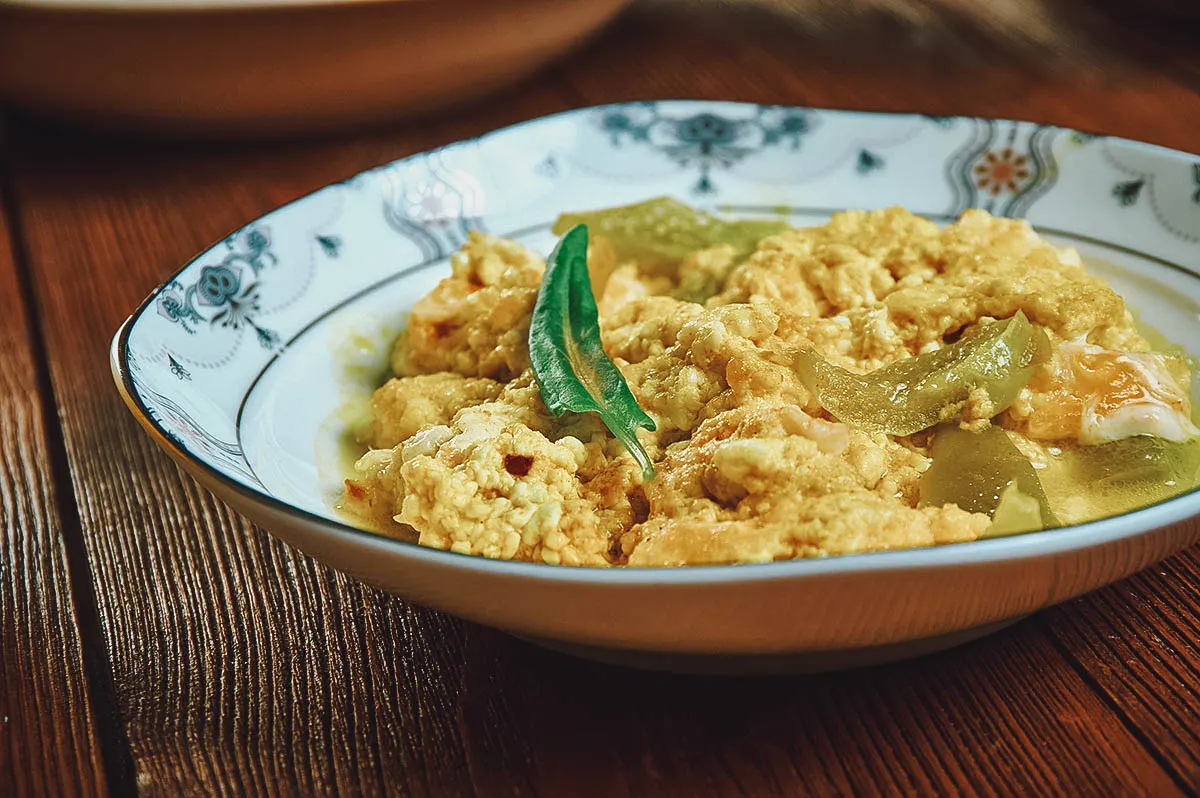
Photo by fanfon
15. Buticha
Buticha refers to an Ethiopian dip made with chickpeas or fava beans mixed with onions, peppers, lemon juice, olive oil, mustard, cloves, and other spices. It’s an easy-to-make dish prepared by blending the ingredients together until a smooth consistency is achieved.
Here you can see buticha served as part of a larger platter with other vegetarian dishes like misir wat and timatim salata.
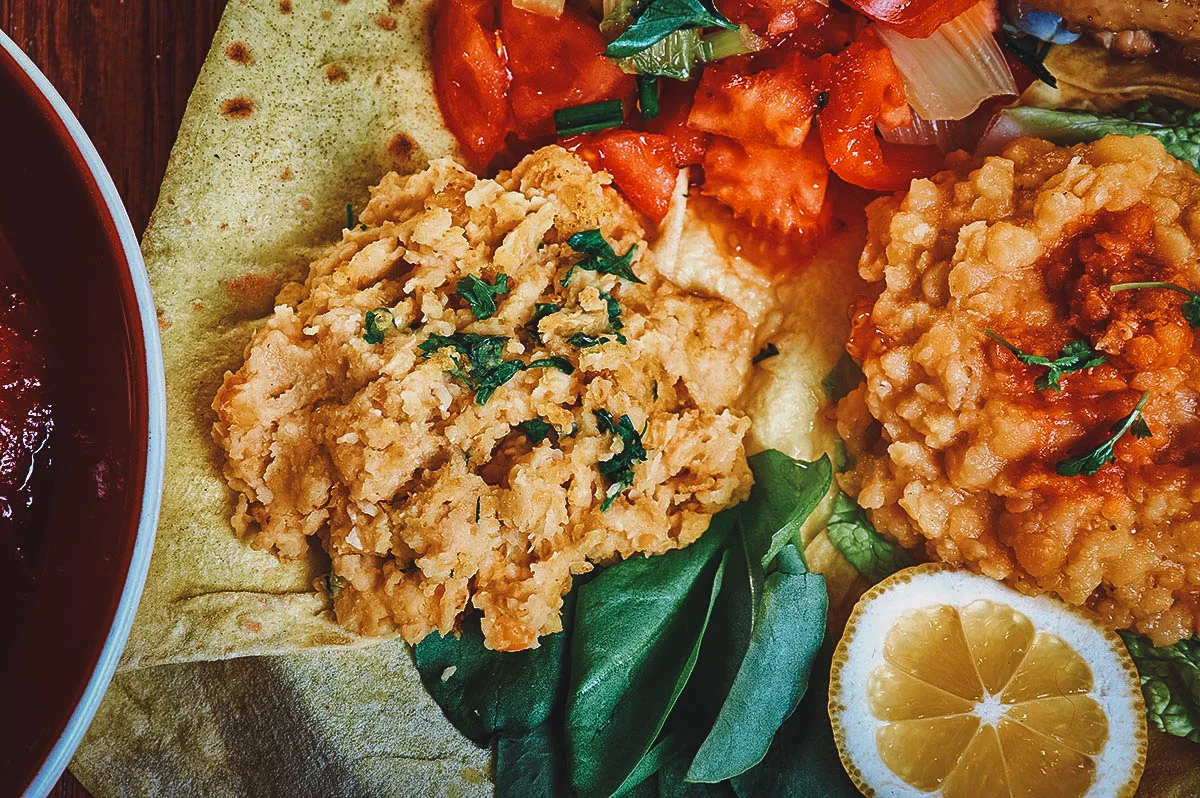
Photo by fanfon
16. Timatim Salata
Timatim Salata refers to a type of fresh Ethiopian tomato salad that’s also popular in Eritrea. It’s made with diced tomatoes, minced onions, and finely chopped peppers dressed with a mixture of berbere spices, olive oil, vinegar, and lemon juice.
Like many of the dishes in this Ethiopian food guide, it’s commonly served as part of mixed platters at Ethiopian restaurants. When made with shredded injera, it becomes known as timatim firfir.
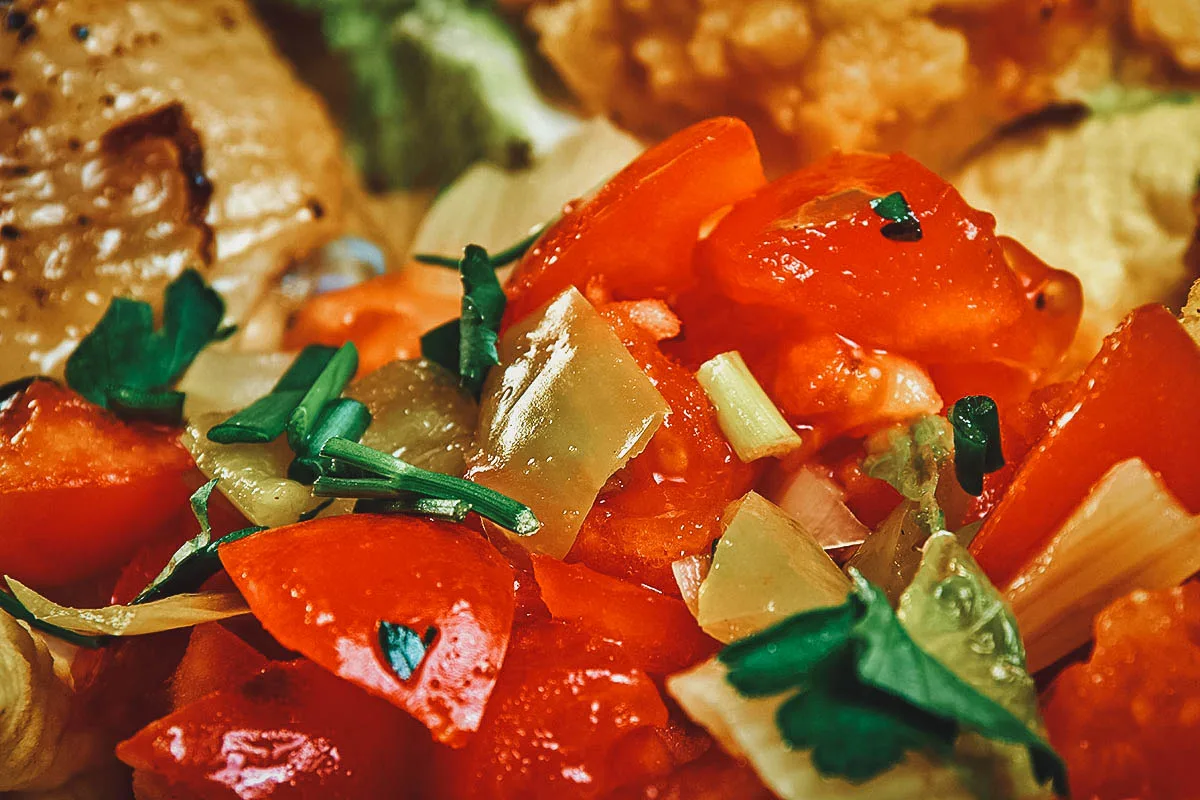
Photo by fanfon
17. Fossolia
Fossolia is a simple vegetable dish made with green beans as its primary ingredient. The beans are cooked till tender with other ingredients like onions, garlic, ginger, carrots, tomatoes, and black pepper.
Fossolia is typically served as a side dish with injera and as part of larger platters at Ethiopian restaurants.
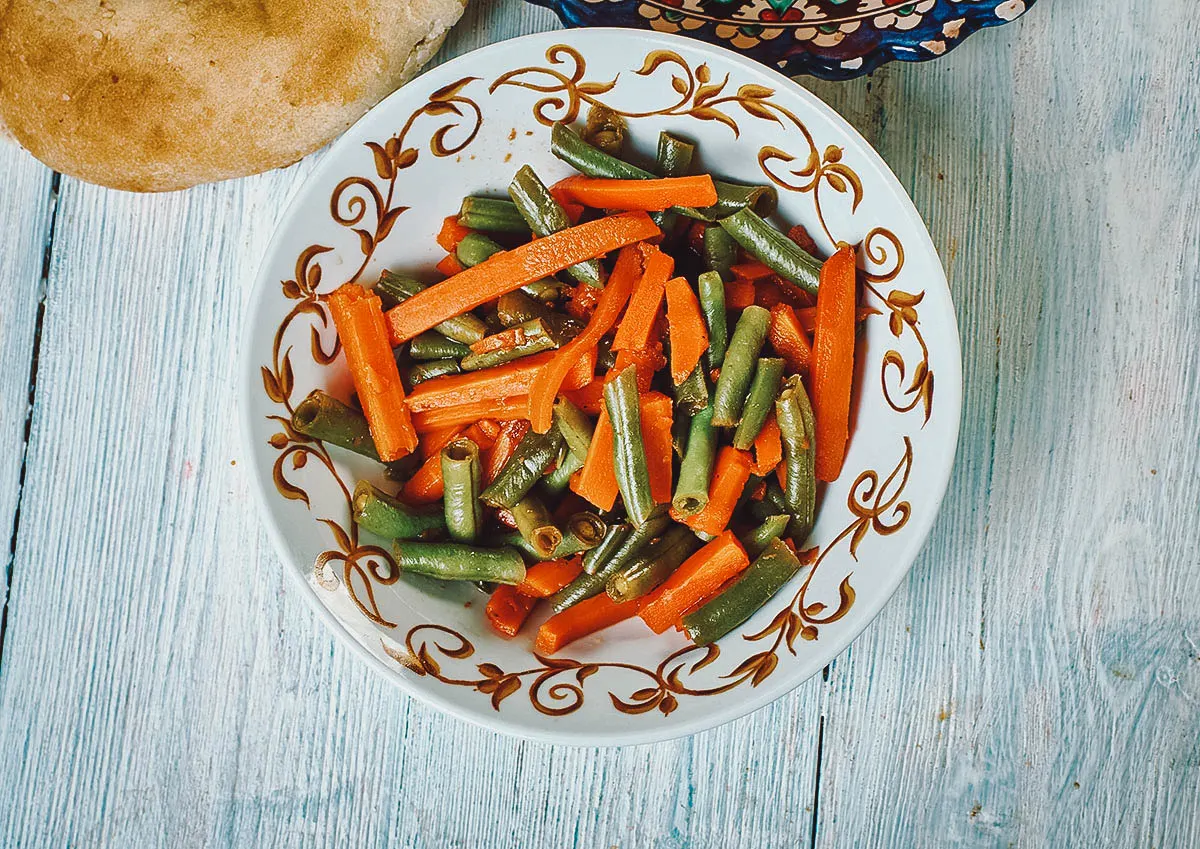
Photo by fanfon
18. Yataklete Kilkil
Yataklete kilkil refers to an easy-to-make Ethiopian vegetable dish consisting of boiled potatoes, green beans, and carrots simmered with garlic, sautéed onions, peppers, and tomatoes. It’s eaten with injera and seasoned with a variety of spices like paprika, turmeric, coriander, cumin, and black pepper.
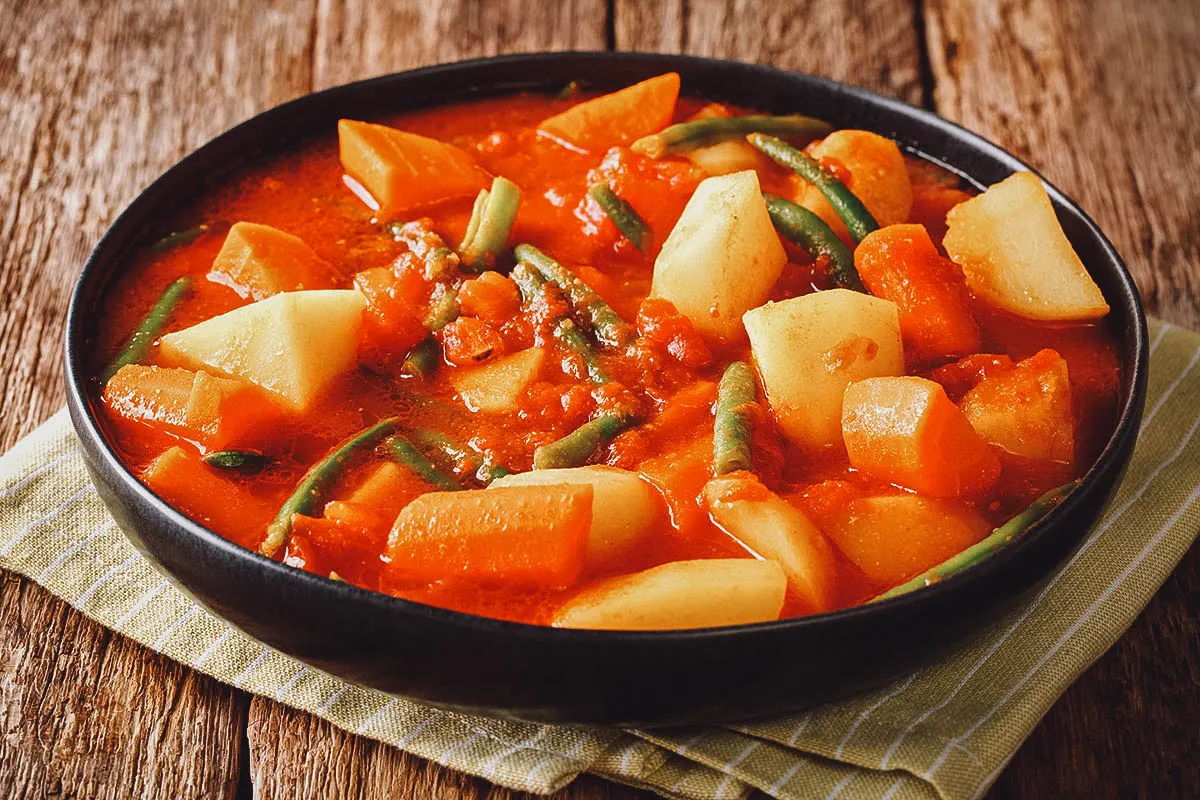
Photo by lenyvavsha
19. Yetsom Beyaynetu
If you find yourself at a restaurant in Addis Ababa on a Wednesday or Friday and are unsure what to get, then you may want to go with the yetsom beyaynetu. It doesn’t refer to any specific Ethiopian dish but a mixed platter of strictly vegan dishes served with injera. Yetsom means “fasting” while beyaynetu means “a bit of every type”, so yetsom beyaynetu is essentially a communal platter of fasting food.
Only vegan food is served on fasting days so every Ethiopian restaurant in Addis Ababa will offer some form of yetsom beyaynetu on Wednesdays and Fridays. They’re comprised of different stews and curries, many of which are featured in this Ethiopian food guide. It’s a great way of sampling as many meat-free dishes as possible in one sitting.
Like India, Ethiopia is one of the easiest places in the world to be vegan or vegetarian and yetsom beyaynetu is a testament to that.
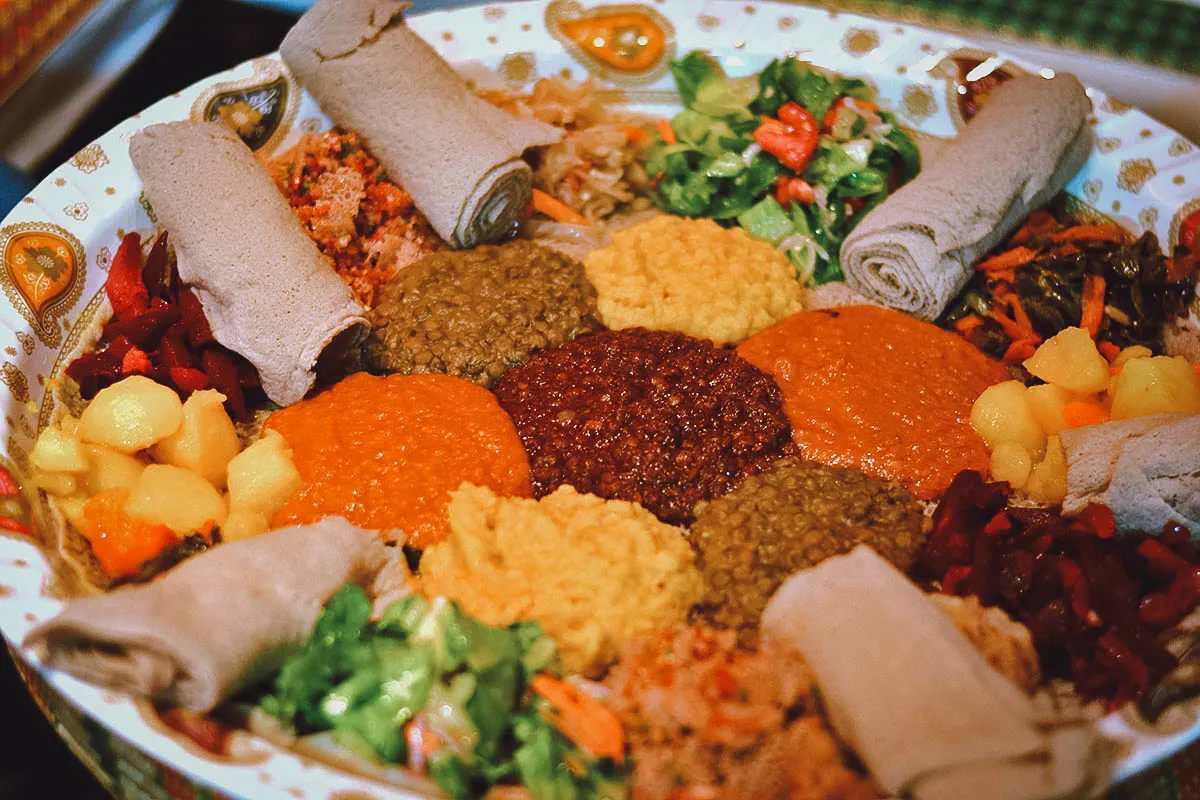
Photo by jayantbahel
ETHIOPIAN DRINKS
20. Ethiopian Coffee
Coffee isn’t just a beverage in Ethiopia, it’s an important part of Ethiopian culture.
Unlike in western societies where coffee is often consumed alone, coffee drinking in Ethiopia is a social and ceremonious event that always requires company. In fact, to be invited to a coffee ceremony is considered a mark of friendship and one of the best examples of Ethiopian hospitality.
An Ethiopian coffee ceremony is steeped in ritual and can take several hours. It begins with the washing and roasting of the beans on a mitad. When the beans are roasted, they’re brought to the guests so they can smell the aroma of the beans.
The beans are then ground in a mortar and brewed in a traditional clay coffee pot called a jebena. When ready, the coffee is poured into cups and then served to the guests with traditional Ethiopian snacks. Incense like frankincense and myrrh are burned to drive away evil spirits while the guests converse and enjoy their coffee.
In Ethiopia, it’s considered rude to leave a coffee ceremony without consuming at least three cups of coffee. Ethiopians believe that your spirit is transformed after completing all three rounds.
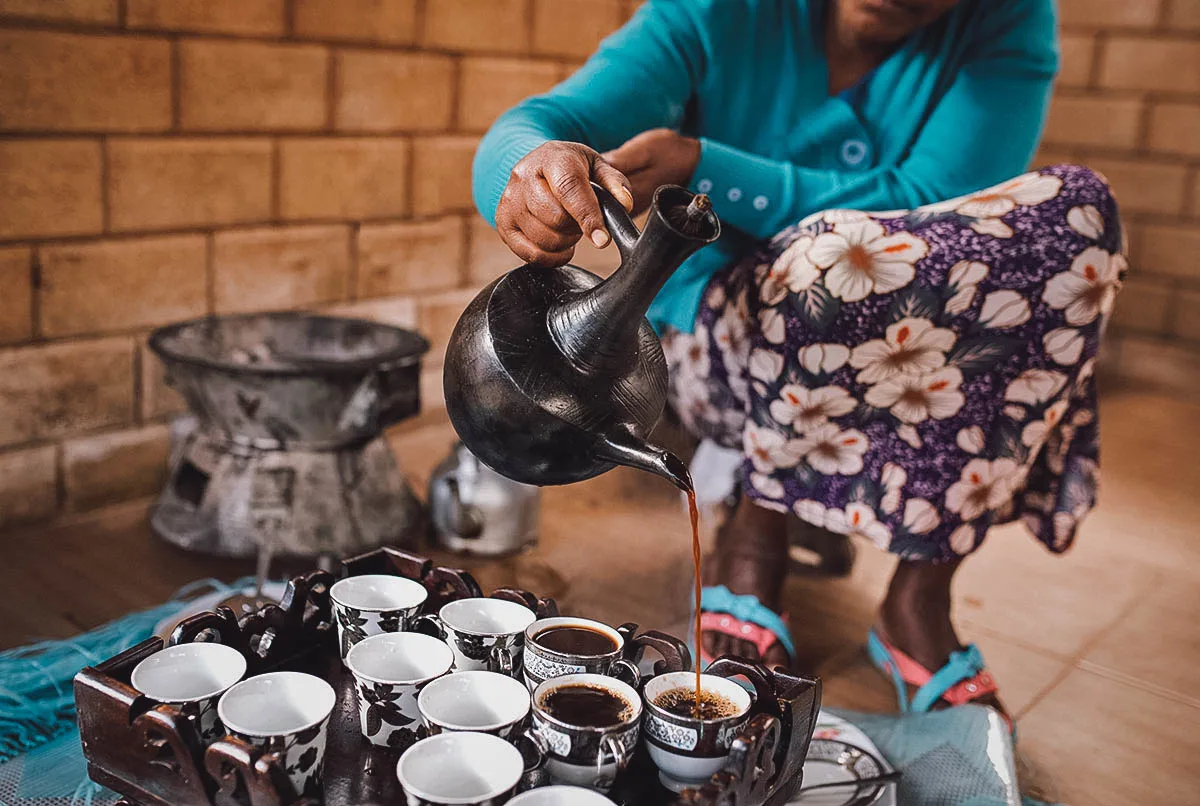
Photo by Wollwerth
Ethiopia is considered the birthplace of the coffee plant which helps explain its role in Ethiopian society.
Legend has it that coffee beans were discovered by an Ethiopian goat herder around 800 CE. He became concerned when his goats grazed on the red fruit of an unknown plant and started acting strangely. He brought the mysterious fruit to nearby monks who then tossed them into a fire as a way of ridding themselves of something they didn’t understand.
But then two miraculous qualities were discovered. First, roasting the coffee beans released their aroma. And second, grinding the beans and steeping them in water created an invigorating drink that allowed the monks to continue their prayers well into the night. From there, coffee was created and spread throughout Ethiopia and the rest of the world.
Today, Ethiopia is the largest producer of coffee in Africa and the 5th largest in the world. They account for about 4.2% of the world’s coffee production. But unlike other major coffee-producing countries that consume only a small percentage of their coffee, Ethiopians consume as much as 50%, which is a testament to just how important coffee is to everyday life in Ethiopia.
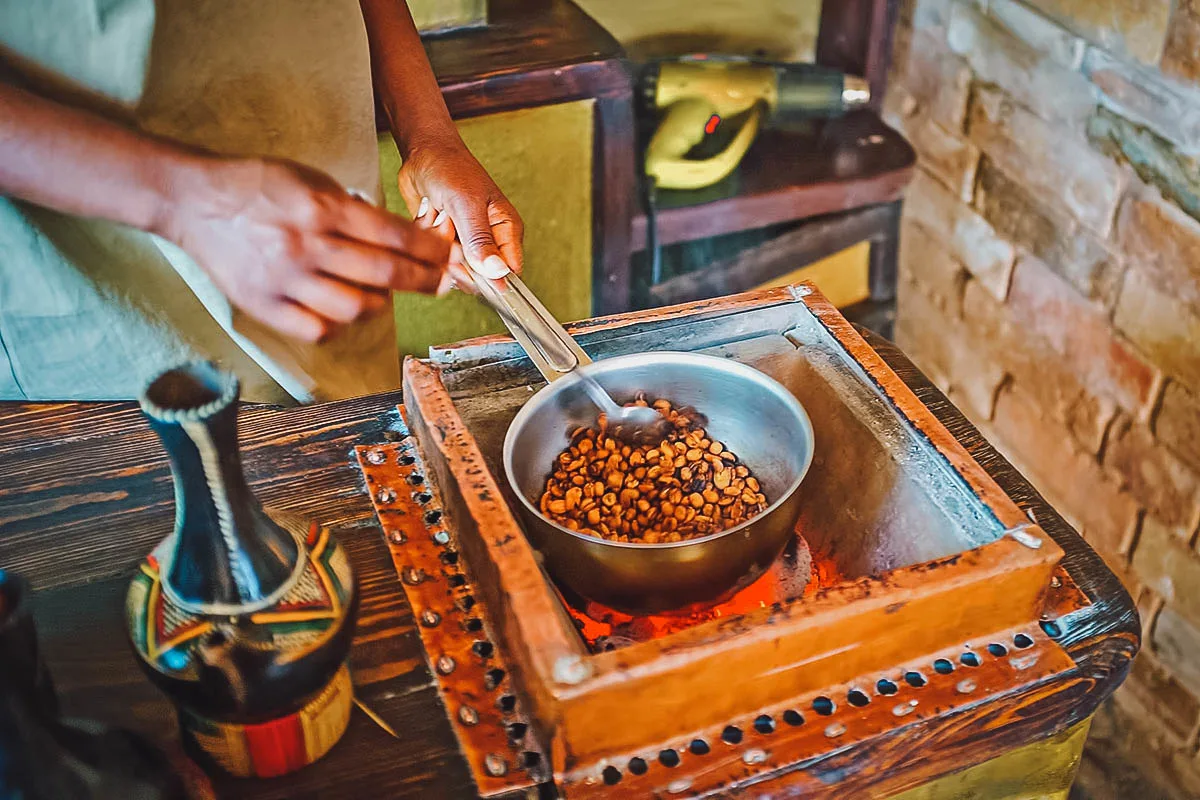
Photo by efesenko
ETHIOPIAN FOOD TOURS
Simply put, no one knows Ethiopian food better than a local, so what better way to experience the cuisine than by going on an Ethiopian food tour? Not only will a guide will take you to the city’s best restaurants, markets, and street food stalls, but they’ll be able to explain the many dishes to you in more detail.
On top of that, eating Ethiopian food is a communal affair so going on a group tour is a great way for solo travelers to experience the cuisine in the company of others.
Check out Get Your Guide for a list of Ethiopian food tours in Addis Ababa and in other destinations throughout the country.
FINAL THOUGHTS ON ETHIOPIAN FOOD
I love eating Ethiopian food. It’s a full sensory experience that’s a treat to the eyes, nose, taste buds, and fingertips. It’s mesmerizing from start to finish and the type of meal you’ll remember for a long time.
Ethiopian food is still relatively unknown but thanks to the diaspora, it’s become more available in different parts of the world like North America, the Middle East, and Europe. There are an estimated 460,000 people of Ethiopian descent living in the United States, the vast majority of which are in the Washington, DC area. If you’ve never tried Ethiopian food and have the chance to do so, then I strongly recommend it.
As good as Ethiopian food is in the US, nothing beats having it having it where it’s originally from so I’m counting the days when I can finally try Ethiopian dishes like doro wat, shiro wat, and injera in Addis Ababa. If it’s as good as those Ethiopian meals in Washington, DC almost thirty years ago, then I’ll probably remember it for the rest of my life.
Disclosure
Some of the links in this Ethiopian food guide are affiliate links. If you make a booking, then we’ll earn a small commission at no additional cost to you.
As always, we only recommend products and services that we use ourselves and firmly believe in. We really appreciate your support as it helps us make more of these free travel and food guides. Thank you!
Cover photo by derejeb. Stock images via Depositphotos.


Esubalew
Thursday 15th of September 2022
I tried most of the foods and I visited the country too.
It's the best taste I ever had!
JB & Renée
Thursday 15th of September 2022
Isn't it amazing? Really hoping I can finally go in 2023!
abbabe
Monday 27th of December 2021
All i heard one travel to ethiopia if you are fat to loose weight.